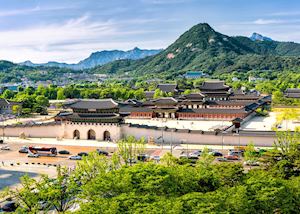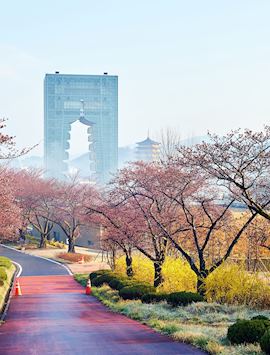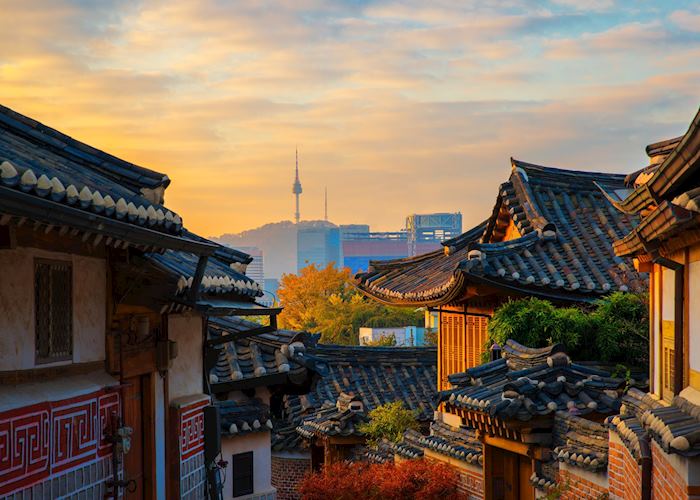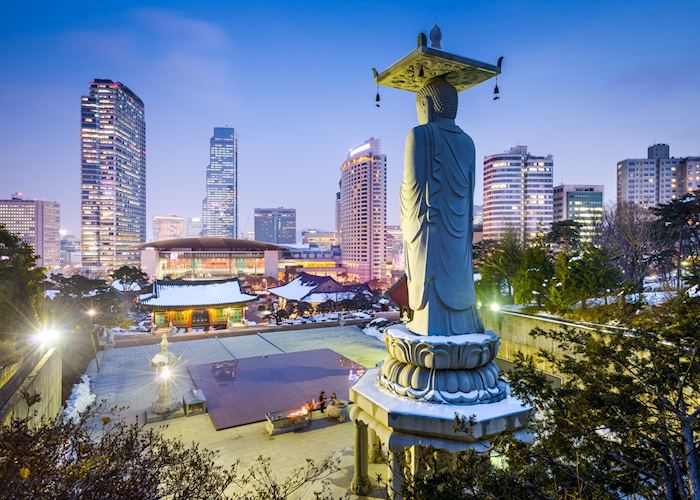Jump to:
Grand palaces, traditional markets and sacred shrines sit side-by-side with towering skyscrapers, colossal malls and karaoke bars in Seoul, South Korea’s fast-paced capital city. You can gorge on some of Asia’s most interesting street food, drink beer with the locals in a pop-up tent bar, search for antiques and contemporary art, or browse the city’s traditional markets at any time of day or night.
A highly efficient metro system makes it easy to navigate between traditional palaces, tea rooms and bathhouses and the city’s four guardian mountains, where a network of trails and parks offers plenty of green relief from the city streets.
South Korea specialist RorySeoul is a real paradise for food lovers. You can’t go more than a few blocks before hitting a food market or street fringed with food stalls. South Korean cuisine is particularly innovative, with vendors trying to outdo each other to create the latest innovative new trend. In the evening, there’s an atmospheric buzz as city workers dine with friends and family.
Things to see and do in Seoul
Gyeongbokgung Palace and Gwanghwamun Gate
 Of Seoul’s five Joseon-era royal palaces, the Gyeongbokgung Palace is by far the largest. It served as the king’s main residence and the seat of the government from 1395 until 1592 when it was destroyed by fire in the Imjin War. Rebuilt in 1865 and meticulously restored, the main entrance to the sprawling walled palace complex is the imposing Gwanghwamun Gate. Inside, some 300 buildings once played host to the royal court along with 3,000 staff.
Of Seoul’s five Joseon-era royal palaces, the Gyeongbokgung Palace is by far the largest. It served as the king’s main residence and the seat of the government from 1395 until 1592 when it was destroyed by fire in the Imjin War. Rebuilt in 1865 and meticulously restored, the main entrance to the sprawling walled palace complex is the imposing Gwanghwamun Gate. Inside, some 300 buildings once played host to the royal court along with 3,000 staff.
The main palace building, Geunjeongjeon, sits in a large courtyard surrounded by wooden cloisters. Carved stones mark the spot where officials lined up according to rank to hear the king speak, while inside, are the king’s official chambers. You can also see the state rooms, Gyeonghoeru, in a raised pavilion overlooking an artificial lake, the king and queen’s private chambers, landscaped gardens and explore the collections at the National Folk Museum and National Palace Museum.
Insadong and Bukchon Hanok Village
You’ll feel the change of pace as soon as you wander down the twisting lanes of Insadong, an altogether quieter and calmer city district. The tangle of narrow alleys is lined by tiny shops selling ceramics, handmade paper, embroidered fabrics and dragon’s beard, a traditional, hand-pulled candy.
Just to the north, the Bukchon Hanok Village has the city’s largest collection of hanok, traditional clay-tiled, wooden houses. Wander the narrow streets, visit a teahouse or get an insight into the history and architecture of the district at the Bukchon Traditional Culture Center.
Myeongdong
Best known as Seoul’s busiest shopping district, you’ll find the city’s best department stores, the sprawling, 24-hour Namdaemun Market and a host of street vendors here. However, beyond the fashion brands and wholesalers, the district is also home to Seoul City Hall, the Myeongdong Nanta Theatre, which hosts folk music performances, and the 16th-century Deoksugung, one of Seoul's five palaces.
Visit in the evening to see it illuminated, or combine a visit with a trip to Namsangol Hanok Village located in the park at the foot of Namsan Hill, one of the city’s guardian mountains. It features five traditional houses showcasing peasant and aristocratic living during the Joseon Dynasty (1392 to 1910).
Gwangjang Market
 There are few places in the country where you’ll find a more diverse slice of local life than in one of Seoul’s sprawling markets. Busy, noisy and smelly at times, they take up swathes of city districts and sell everything from discounted jeans and fried dumplings to live octopus and traditional wedding gifts. Gwangjang Market is one of the best to visit and is a great spot to try local street food such as bindaetteok (crispy mung bean pancakes) or mayak gimbap (seaweed rolls stuffed with pickled vegetables). You’ll also find traditional and vintage clothing, silks, satins and linens, bedding and all manner of household items.
There are few places in the country where you’ll find a more diverse slice of local life than in one of Seoul’s sprawling markets. Busy, noisy and smelly at times, they take up swathes of city districts and sell everything from discounted jeans and fried dumplings to live octopus and traditional wedding gifts. Gwangjang Market is one of the best to visit and is a great spot to try local street food such as bindaetteok (crispy mung bean pancakes) or mayak gimbap (seaweed rolls stuffed with pickled vegetables). You’ll also find traditional and vintage clothing, silks, satins and linens, bedding and all manner of household items.
War Memorial of Korea
Documenting the history of the Korean War (1950 to 1953) as well as historic battles against the Chinese, Japanese and Mongols, this huge museum offers an insight into the military history of the country and acts as a symbol of hope for its peaceful reunification. As you enter, you pass along a memorial walkway inscribed with the names of Allied casualties, while inside, six large halls display large-scale paintings depicting battles, weapons, uniforms, documentary footage and interactive simulated battlefields. Outside, the exhibits continue in the extensive gardens.
The Demilitarized Zone (DMZ)
The tense no-man’s land that separates North and South Korea sits about 55 km (34 miles) north of Seoul and can be visited on a day trip. Established in the 1953, the 4 km (2.5 mile) wide DMZ is most easily accessed at the Joint Security Area (JSA) in Panmunjom. Here you can see the blue Military Armistice Commission Conference Room where the 1953 treaty was signed, it straddles the border and offers a chance to enter North Korea safely, if momentarily. Along with soldiers from both sides, and a lot of barbed wire, you can visit a lookout to see two villages trapped within the DMZ and the ‘Bridge of No Return’ where prisoners of war were exchanged in 1953.
Bukhansan National Park
Another good day trip from the city, but far more relaxing, is a visit to nearby Bukhansan National Park. A network of trails leads through the park’s densely forested mountains to over 100 Buddhist temples, bald granite peaks and the Bukhansanseong Fortress which was first constructed in 132 AD, expanded the 18th century and now surrounded by an extended defensive wall. You can take leisurely walks along gushing mountain streams, strenuous hikes up mountain ridges or tackle technical climbs on granite cliffs. The park is accessible on the city metro system and can get busy, especially at weekends, but hike far enough and you’ll soon leave the crowds behind.
Best time to visit Seoul
The best time to visit Seoul is between late March and May or October and November. In late March and early April, you’ll see cherry blossom in bloom, May and October are comfortably warm, and November has vibrant autumnal foliage. June to August is the hot, humid rainy season, September brings a risk of typhoons, while December to March is very cold.
who's been there
- 617-861-6421
- Make an inquiry
Suggested itineraries featuring Seoul
Our itineraries will give you suggestions for what is possible when you travel in Seoul, and they showcase routes we know work particularly well. Treat them as inspiration, because your trip will be created uniquely by one of our specialists.
Places near Seoul
- Gyeongju 277 kilometers away
- Busan 326 kilometers away
- Jeju island 469 kilometers away
Photos of Seoul
Accommodation choices for Seoul
We've selected a range of accommodation options for when you visit Seoul. Our choices usually come recommended for their character, facilities and service or location. Our specialists always aim to suggest properties that match your preferences.
-
![Superior double]()
L7 Myeongdong
Seoul -
![Lobby]()
Four Seasons Seoul
Seoul -
![Family twin]()
Hotel 28 Myeongdong
Seoul
Ideas for experiencing Seoul
Our specialists seek out authentic ways to get to know the places that could feature in your trip. These activities reflect some of the experiences they've most enjoyed while visiting Seoul, and which use the best local guides.
-
Street food tour of Seoul ![Street food in Seoul]()
Street food tour of Seoul
Street food tour of Seoul
Eat like a local as you discover Korean foods with a local guide. This tour takes in Seoul’s markets as you try classic dishes, learn about local ingredients, side dishes and sauces, and understand the importance of food in Korean culture.
View details -
Tour to the North Korean border zone ![DMZ]()
Tour to the North Korean border zone
Tour to the North Korean border zone
A buffer zone between North and South Korea, the Demilitarized Zone can only be visited on a guided tour which offers the chance to see its observation posts and tunnels and learn about the history of the Korean War.
View details



















